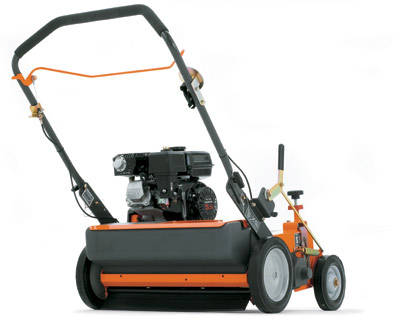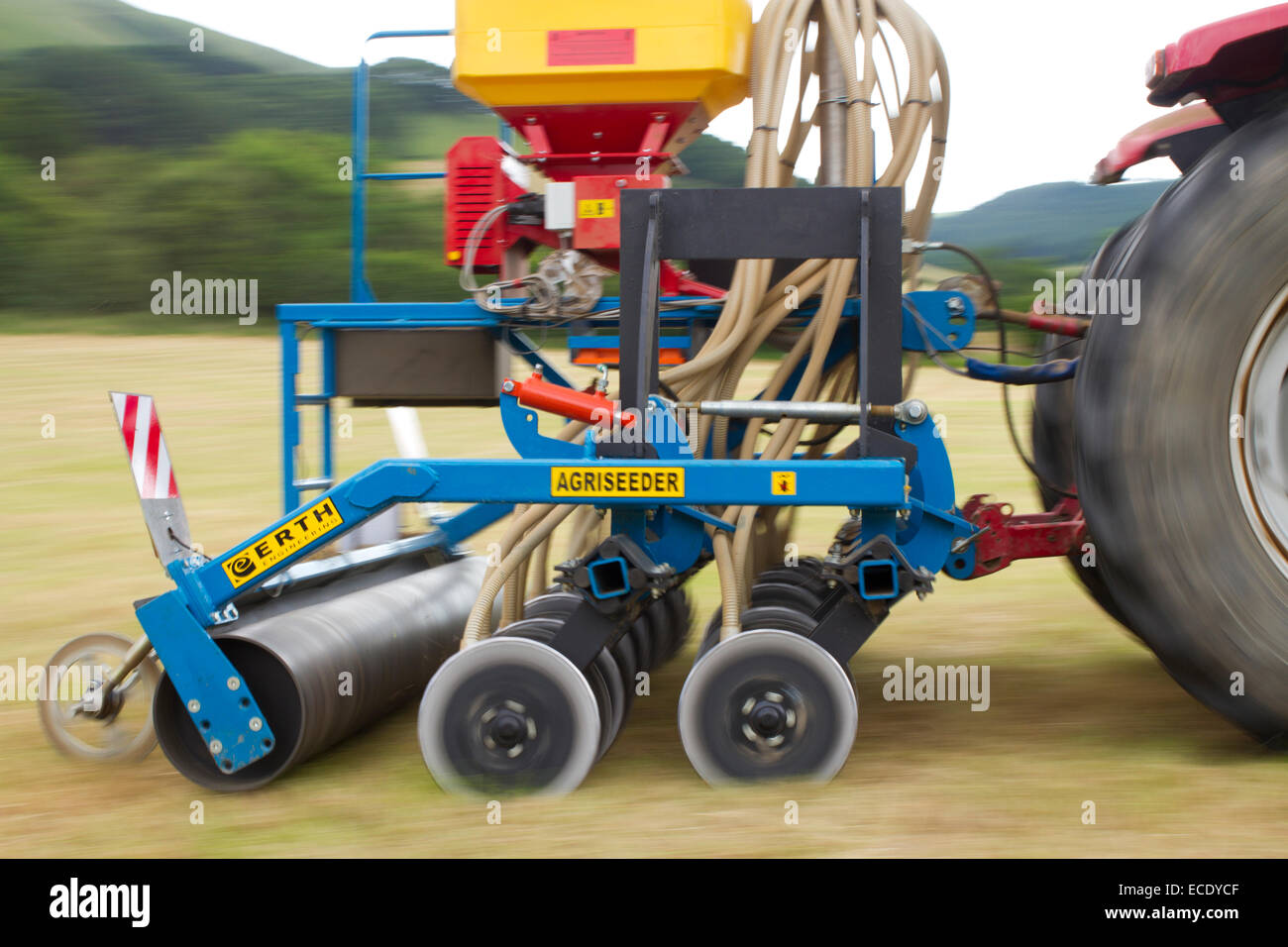Slot Seeder
What do these machines do, why do we need to use them, and when should we use one or the other or both? Let’s take a look at what your lawn needs in order to flourish, and then find out what these lawn maintenance machines do to help you help your lawn!
Grass seeds need direct contact with a good growing medium (the soil), as well as sufficient moisture in order to germinate. But this is only the beginning—once the seeds germinate, the plant roots need continued feeding from the soil nutrients and other supplements in order to thrive. Ongoing moisture delivered to the growing root zone is also necessary. Please see our article: How To Seed A Lawn
Many people think the purpose of the aerator is to simply poke holes into the surface of the ground over which you will then broadcast grass seeds. The seeds, they assume, will fall into the holes and later emerge as grass plants, sort of like digging a hole and inserting a bean seed into it in order to grow a bean plant. With lawns, this is not exactly how it works.
Running over your lawn with an aerator actually serves multiple purposes. The most obvious ones are to help alleviate compaction of the soil, to allow moisture (either from rainfall or from irrigation sources) to better enter the soil, and to allow fertilizers and other plant supplements such as lime to better infiltrate and mix with the soil, and to feed the grass roots at a deeper level in order to encourage stronger and deeper development of the root system.
Another purpose of aeration is to allow air to enter the soil to help carry out proper workings of bacteria that help break down organic matter on and in the soil. In this way, the grass clippings and the dead and dying grass plants or weeds and their roots will decompose and turn to humus which will actually feed the roots of the healthy lawn grasses. A sufficient amount of air is also necessary in order for the minerals in the soil to be transformed into forms that are usable by the grass plants.
Now, what does a slit-seeder do? Well, we don’t want to make this more complicated than it really is, so, here’s the answer—a slit-seeder slits the soil and drops seeds into the slits it makes! The machine has a series of rotating knives that operate in the same fashion as a reel-type lawnmower. These knives cut into the soil forming narrow grooves, the depth of which is determined by adjusting the machine. The hardness of the soil, usually related to the moisture content, is also a factor in how deeply the knives will cut. A small hopper mounted on the machine is filled with grass seed that is dispersed onto the soil at a rate that is determined and adjusted by the machine’s user.
So, that’s it—an aerator pokes holes into the soil to alleviate compaction, and to allow air, fertilizer, and moisture into the soil closer to the roots of the grass. A slit-seeder slices the surface of the soil and distributes seeds onto and into the soil. Okay, then, when should we use what?!
If you have a pretty good thick stand of desirable lawn grass already growing, use the aerator and follow up with a good program of lawn fertilizers. Also read: Numbers On The Fertilizer Bag. As your lawn continues to thrive, aerate every year or two.
If your lawn is spotty, with some areas of desirable grass growing but other areas of thin or no grass, then use the slit-seeder. If your spotty lawn is also compacted or hasn’t been attended to in awhile, you might want to use both machines.
And, in the most severe case of all, that being a very poor lawn which has mostly weeds or very little desirable grasses on it, the best advice might be to just till up the whole thing and re-seed from scratch. That way, you can establish a nice lawn, and then keep it healthy with periodic uses of either the lawn aerator or the slit-seeder. Stay green!


| Are your grass leys looking tired? Have you been told to plough up your grass? Here's the easy answer to rejuvenate your grassland. Establish a new ley without disturbing the topsoil, (or burning lots of diesel!) | ||
| The Slot Seeder places grass, clover, or other seed into the ground by cutting a groove with two offset discs per slot. The seed is blown into the gap, which is then closed up by a large ballasted flat roll. The slots are spaced 70mm apart which allows the seed sufficient growth space, but also enables existing grass to survive. A single pass with the seeder is sufficient to drill a completely new ley in bare topsoil, or stitch in a new variety to an existing ley. Clover, mustard, rape, and cover crops can also be established using the same system - effectively a no-till drill for cover crops and grass! | ||
| Refresh your Grassland | ||
| Slot Seeding enables new seed to be placed into existing grass that is still in use. Ideally a period without grazing would follow the seeding, however because the seed is placed in the soil, it won't suffer from being trampled. Clover can easily be stitched in to existing grassland. Additionally the seed is not exposed to birds, or the weather which significantly raises chances of germination. | ||
| Simple Reliable Seeding | ||
| In the image on the right you can clearly see discs, scrapers and individual spring units that allow the machine to safely follow the contours of even rough fields without damaging the discs or interrupting the drilling process. Drilling a 5.8metre pass, larger areas can be drilled quickly and accurately with minimum wheelings. | ||
| Ideal for Sports fields + GPS | ||
| The drilling method employed on our machine is the exact same system used by many sports field contractors, and top sports venues, for football, golf and polo pitches. With a 95% germination rate, you can be assured a quality finish, even on grazing and cropping ground Using a GPS unit to offer guidance ensures that nothing is missed, and on sports fields ensures straight lines and an even pitch surface. | ||
| Park up your plough! | ||
| Even if your grass is beyond help there's still no need to 'plough it up'! With the Slot Seeder, you need only spray the grass and weeds off, flail any thick vegetation, and then Slot Seed. If your ground is very compacted then a pass with the Sward Lifter may be advisable, but the total cost will still be significantly lower than ploughing up and re-drilling. Additionally your ground will be firm enough to graze or crop as soon as the grass growth allows. | ||
| Contact us for prices and availability / timings | ||
Slot Seeder Hire

Slot Seeding

Slot Seed Drill
How to Overseed with a Split / Splice Seeder. Billy Goat Model: OS900SPH lawn overseeder Today we used: Barenbrug Kentucky Bluegrass https://www.amazon.com/g. To start, fill the slit seeder with seed. The most common setting for the slit seeder is to lay about 5 pounds of seed per 1,000 square foot. Once set and ready walk the seeder from one end of the lot to the other in a straight line. Depending on the slit seeder it will place seed in the slits in rows around 4 inches apart. The Slot Seeder places grass, clover, or other seed into the ground by cutting a groove with two offset discs per slot. The seed is blown into the gap, which is then closed up by a large ballasted flat roll. The slots are spaced 70mm apart which allows the seed sufficient growth space, but also enables existing grass to survive. The Classen TS-20 turf overseeder makes seeding a new lawn or overseeding an existing lawn quick, easy and rewarding. Serious lawn care made easy! No hassle easy to locate and use handle-mounted controls take the guess work out of machine operation. Open design for easy access to all touch points.